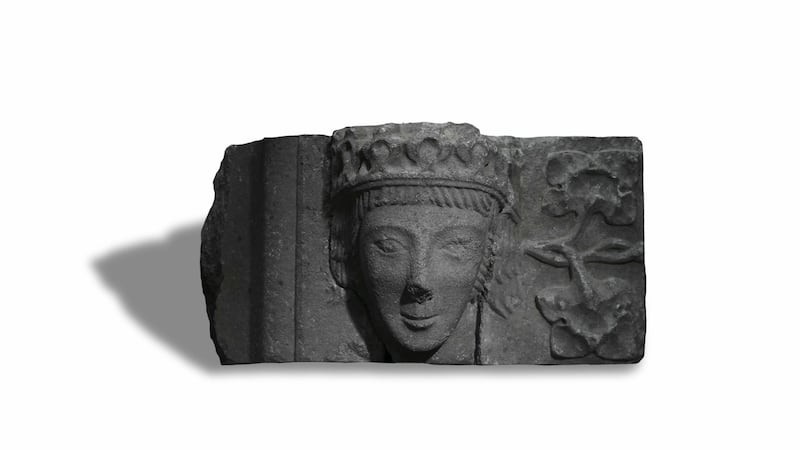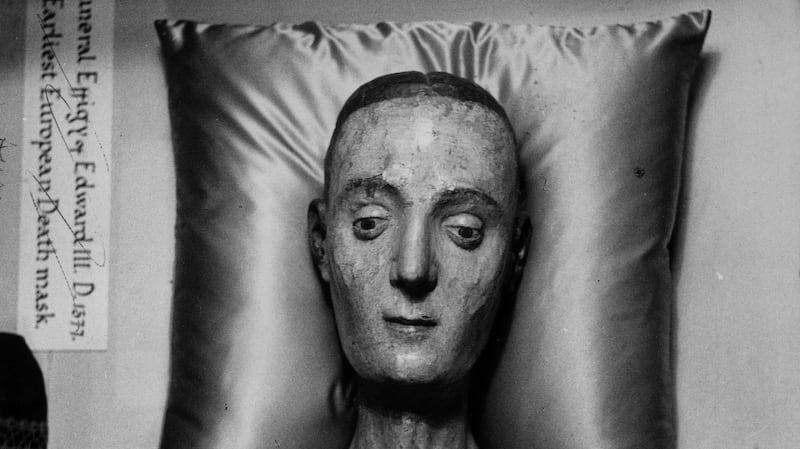A carved stone head of a woman – found in a pile of rubble in a field in Co Meath – could be an extremely rare depiction of Catherine of Valois, a 15th-century Queen Consort of England. It will go under the hammer at Adam's auctioneers in Dublin in April with a top estimate of €30,000. But how did it end up in the countryside in Ireland and why is it potentially so important?
Where and when was it found?
It was found by the vendor – who has consigned it to be auctioned – almost 50 years ago on land he owns in Co Meath. The man, who wishes to remain anonymous, told The Irish Times that when digging to put in a septic tank he had been "clearing a pile of rubble" and was "going to use the stones as infill" when he spotted the stone carving. He consulted the well-known Co Meath historian, Elizabeth Hickey. She spent years researching it and published her findings in the Journal of the Royal Society of Antiquaries of Ireland in 1985.

What did Elizabeth Hickey conclude?
According to Adam's, her research concluded that the carving was made in the 15th century, had been part of the decoration of the east window of a church at Stackallen, Co Meath, and, most crucially, identified the head as depicting Catherine of Valois.
Is that a big deal?
Yes. Images of Catherine of Valois are extremely rare. And for one to turn up in Ireland almost 600 years after her death is astonishing. Adam’s described it as “of immense historical interest and rarity”.
Who was Catherine of Valois? [Also known as Catherine de Valois]
Catherine of Valois was a French princess – born in 1401 – the daughter of King Charles VI of France. Ironically, although her country was at loggerheads with England in a conflict known as The Hundred Years' War, at the age of 19 she married King Henry V of England, who had inflicted a terrible defeat on the French at the Battle of Agincourt a few years earlier. Catherine was Consort Queen of England for just two years – from 1420 to1422. Henry V died in 1422, leaving her a widow at the age of only 21. Their son became Henry VI. Catherine lived until 1437 – and reputedly had an affair with Owen Tudor, whose son eventually became Henry VII and launched England's Tudor line of monarchy.
How did Elizabeth Hickey identify the carving?
The breakthrough in her research came when she visited Westminster Abbey in London and saw the funeral effigy of Catherine of Valois. A medieval funeral effigy was a life-size representation of the deceased made of wood and wax, which was dressed in robes and jewels and carried during funeral processions. By coincidence, Catherine of Valois' funeral effigy (and those of other royals) will go on public view from this summer when the new Jubilee Galleries in Westminster Abbey are opened.
Why was the carving found in Meath?
The carving is believed to have formed part of the decoration of the east window of Stackallen Church when it was built in the late 14th-early 15th century on an existing early Christian site. It is believed the church was re-built a couple of times since then – but the carving survived each re-build. However, its significance appears to have been forgotten in time. Then, in 1960, the church was apparently deemed surplus to requirements, and was demolished. Adam’s said that before the demolition, the building had been surveyed by the Office of Public Works and that “some of its decorative features were removed to nearby Slane Protestant Church”. But not, apparently, the carving. The vendor said the building was then blown up with dynamite. The stone with the carving presumably ended up in the leftover rubble until it was found a decade later.
Who was Elizabeth Hickey?
Elizabeth Hickey was a Co Meath historian and author who lived at Skryne Castle near Tara. She died in 1999 aged 81. She was born in Scotland and moved to Ireland as a child. She wrote numerous books including The Green Cockatrice (under the pseudonym Basil Iske), which controversially posited the theory that the plays of Shakespeare were, in fact, the work of a 16th-century Co Meath big-wig, William Nugent, Baron of Skryne. She was a graduate of Trinity College and had a colourful and varied career which ranged from dress designing (including a stint in the Gate Theatre costumes department), teaching in Wales and Derry, and assisting in the archaeological digs at Tara. She wrote extensively about the county's history and was a leading member of the Meath Archaeological and Historical Society.
What’s the view of the auctioneers?
Adam’s said Elizabeth Hickey’s opinion, as published in 1985, has not been challenged and also added: “In medieval times, churches in the Pale had their Gothic windows adorned with heads, in each case a king and a queen at the stops of the moulding, and with a bishop at the apex. This seems to have been a conventional arrangement with the Pale gentry honouring the reigning King of England, from whom they held their lands, and his consort. The date of the marriage of Catherine and Henry in early 1421 ties in directly with the beginning of the Succession List of the Clergy in 1421 and the generally agreed date of the building of the 15th-century Stackallen Church, thus confirming that the stone head is a portrait of Queen Catherine de Valois.”
Apart from Elizabeth Hickey, have other experts seen the carving?
The vendor said in the 1970s he had contacted the National Museum of Ireland about his find and that officials from the museum – and a senior figure from the National Gallery of Ireland – had been shown the carving. He said the museum first asked that he donate or loan it and then offered to buy the carving “for a few hundred pounds”, but he declined.
How rare is Catherine of Valois’ image?
Very. Because her tenure as queen was so short, less than two years, her image is rare. Apart from the aforementioned funeral effigy, she’s depicted in a 15th-century manuscript in the British Library and the National Portrait Gallery in London has an engraving. Therefore, the emergence of this carving is likely to attract interest from Britain and France.

What happens next?
Adam’s said the stone carving will be offered in its ‘History Sale’ in the saleroom at 26 St Stephen’s Green, Dublin 2, on April 24th. The estimate is €20,000-€30,000. Viewing dates and the catalogue will be published after Easter.















